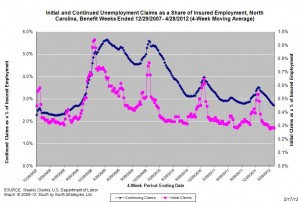No “Springing Forward” For NC’s Labor Market
CHAPEL HILL (May 18, 2012) – The change in seasons was not accompanied by improvements in North Carolina’s labor market. Payroll employment levels essentially were flat in April and were only slightly higher than was the case a year ago. While the unemployment rate fell to the lowest level recorded since early 2009, the drop stemmed from a decline in the size of the state’s labor force, not an increase in employment. These findings come from new data released by the Labor and Economic Analysis Division of the NC Department of Commerce.
“Job growth in North Carolina has slowed steadily over the course of 2012,” said John Quinterno, a principal with South by North Strategies, Ltd., a research firm specializing in economic and social policy. “Compared to last December, North Carolina has 25,900 more jobs, but 85 percent of that gain occurred in January. Over the last two months, North Carolina has essentially netted no new jobs.”
In April, North Carolina employers cut 1,300 more payroll jobs than they added (+/- 0 percent). Private sector payroll levels essentially held steady, (-1,200, +/- 0 percent), as was the case in the public sector (-100, +/- 0 percent). Within the private sector, manufacturing shed the most jobs, (-2,900, -0.7 percent), followed by information (-1,100, -1.6 percent) and other services (-900, -0.6 percent). Professional and business services netted the most jobs (+3,600, +0.7 percent), due mainly to hiring in the administrative and waste management subsector.
A positive revision to the March payroll data found that the state lost 500 fewer jobs than first reported (-800 versus -1,300). With that revision, North Carolina now has, on net, 218,600 fewer payroll positions (-5.2 percent) than it did in December 2007. Since bottoming out in February 2010, the state has netted an average of 4,142 payroll jobs per month, resulting in a cumulative gain of 107,700 positions (+2.8 percent).
“Over the past few years, North Carolina has managed to close some of the job gap caused by the recent recession,” noted Quinterno. “Since last July, the job gap has fallen by a full percentage point, yet compared to December 2007, North Carolina has fewer payroll jobs in every major private industry sector except for educational and health services and professional and business services. The improvements that have occurred have occurred very slowly.”
The household data for April also point to a labor market characterized by widespread joblessness. Last month saw a small increase in the number of employed individuals (+1,471, <0.1 percent) and a decline in the number of unemployed persons (-12,686, -2.8 percent). Yet the size of the labor force decreased by 11,215 individuals (-0.2 percent). It was this decline rather than an increase in employment that pushed the statewide unemployment rate down to 9.4 percent, the lowest level recorded in over three years.
To place the scale of unemployment in context, consider how there were almost twice as many unemployed North Carolinians in April 2012 as there were in December 2007. The statewide unemployment rate also was 4.4 percentage points greater than it was over four years ago. In fact, the monthly statewide unemployment rate has exceeded 10 percent in 35 of the last 40 months. Moreover, the share of the adult population with a job remains at a depressed level.
“While North Carolina’s job market began 2012 moving in a positive direction, it has failed to maintain that momentum,” observed Quinterno. “The state has experienced virtually no net job growth over the last two months. While the unemployment rate has fallen by half a percentage point since February, the decline is due largely to people leaving the labor force. Recovery remains a distant goal for jobless North Carolinians—a goal that still is being measured in terms of years.”



 Email Sign-Up
Email Sign-Up RSS Feed
RSS Feed